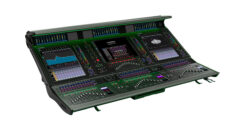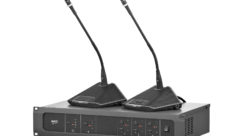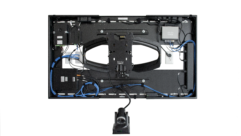Audio Processing Driving Room Devices Too
May 11, 2006 8:00 AM,
By John McKeon
Corporate AV users and their integrators are increasingly focused on “one box solutions” for controlling their presentations, conferences, and other multimedia activities, and they are finding ever-simpler ways to do more with basic systems.
One trend is to put audio digital signal processing (DSP) to work doing more than just adjusting speakers and other audio components. Glenn Polly of Videosonic, New York, notes that most DSP control units come equipped with a serial port which can be used to control a variety of external devices.
“You could turn on a projector, or roll down a screen,” Polly says, citing two common and simple tasks that can be driven through an audio control system. That’s in addition to all the things users normally expect from DSP, including the opportunity to reconfigure audio systems, control amplifiers, and loudspeakers and handle tasks like programming delays.
“The programmability of DSP allows the installer to really dial in the user’s settings,” Polly says. “It isn’t just easier, but the results are also better.”
By taking advantage of a basic feature of the system, the serial interface, installers can also equip their clients to manage other aspects of conference room operations, like closing drapes or turning on a DVD player. All of these functions and presets can be activated through intuitive touchscreen control systems.
Also driving these opportunities is the arrival of a new wave of smaller, cheaper, and easier-to-use DSP systems from provides like Peavey, Electro-Voice, and QSC Audio, Polly says. DSP systems today operate on cheap and ubiquitous Cat-5 cabling, using such common networking environments as CobraNet.
Biamp Systems’ AudiaFLEX, Polly says, is an example of the new generation of DSP, offering control via laptop computer as well as more elaborate remote control panels. It also provides an RS-232 control port to drive external devices.
This programming and alertness to opportunities to maximize functionality are the key to business growth for many integrators, Polly adds. “We’re not making a markup on selling an equalizer,” he notes. “We make money on the programming.”
Part of that programming is selecting video inputs for delivery to the conference room displays. In addition to such playback options as DVD, the audio controller could activate display of incoming television signals, and in this area Polly sees an ever-wider enthusiasm for high-definition content.
Corporate boardrooms and other facilities frequently display such feeds as CNBC, with its continuous stock tickers, much easier to read and understand in a high-definition display.
Moving among these various presentation components and information sources is getting easier all the time. These days, clients can realize more functionality from their basic systems without having to invest in more costly and complex installations.
Full digital signal processing for video is also coming, but in the meantime, many corporate users are finding a strong middle ground just by linking a variety of conference room components to their audio controller.
Polly also sees more and more corporate users taking advantage of common software platforms like Microsoft’s NetMeeting, which enable them to share data and documents and achieve true collaboration over their networks.










